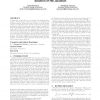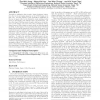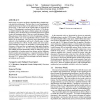DAC
2009
ACM
15 years 16 days ago
2009
ACM
Post-silicon validation has become an essential step in the design flow of today's complex integrated circuits. One effective technique that provides real-time visibility to ...
DAC
2009
ACM
15 years 16 days ago
2009
ACM
Post-silicon processor debugging is frequently carried out in a loop consisting of several iterations of the following two key steps: (i) processor execution for some duration, fo...
DAC
2009
ACM
15 years 16 days ago
2009
ACM
In this paper we introduce a new method of performing direct solution of the harmonic balance Jacobian. For examples with moderate number of harmonics and moderate to strong nonli...
DAC
2009
ACM
15 years 16 days ago
2009
ACM
DAC
2009
ACM
15 years 16 days ago
2009
ACM
Don't-care conditions provide additional flexibility in logic synthesis and optimization. However, most work only focuses on the gate level because it is difficult to handle ...
DAC
2009
ACM
15 years 16 days ago
2009
ACM
As VLSI technology enters the nanoscale regime, interconnect delay has become the bottleneck of the circuit timing. As one of the most powerful techniques for interconnect optimiz...
DAC
2009
ACM
15 years 16 days ago
2009
ACM
Post-silicon validation has recently drawn designers' attention due to its increasing impacts on the VLSI design cycle and cost. One key feature of the post-silicon validatio...
DAC
2009
ACM
15 years 16 days ago
2009
ACM
In this paper, we propose an effective algorithm flow to handle largescale mixed-size placement. The basic idea is to use floorplanning to guide the placement of objects at the gl...
DAC
2009
ACM
15 years 16 days ago
2009
ACM
Elevated chip temperatures are true limiters to the scalability of computing systems. Excessive runtime thermal variations compromise the performance and reliability of integrated...
DAC
2009
ACM
15 years 16 days ago
2009
ACM
Exponentially rising cooling/packaging costs due to high power density call for architectural and software-level thermal management. Dynamic thermal management (DTM) techniques co...



